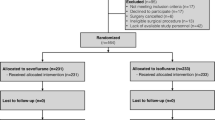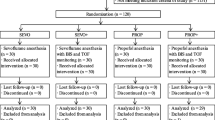Abstract
Purpose
To compare the measured “real world” perioperative drug cost and recovery associated with desflurane- and isoflurane-based anesthesia in short (less than one hour) ambulatory surgery.
Methods
We conducted a prospective, randomized, blinded trial with patients undergoing arthroscopic meniscectomy under general anesthesia. Followingiv induction, patients received either isoflurane (group I;n = 25) or desflurane (group D;n = 20) for maintenance. The primary outcome variable was total perioperative drug cost per patient in Canadian dollars. Secondary outcome variables included volatile agent consumption and cost, adjuvant anesthetic and postanesthesia care unit (PACU) drug cost, readiness for PACU discharge, and incidence of adverse events.
Results
Total perioperative drug cost per patient was $14.58 ± 6.83 (mean ± standard deviation) for group I, and $21.47 ± 5.18 for group D (P < 0.001). Isoflurane consumption per patient was 6.0 ± 3.0 mL compared to 18.6 ± 7.7 mL for desflurane (P < 0.0001); corresponding costs were $0.83 ± 0.42vs $7.61 ± 3.15 (P < 0.0001). There were no differences in adjuvant anesthetic or PACU drug cost. All but one patient from each group were deemed ready for PACU discharge at 15 min postoperatively (Aldrete score ≥ 9). One patient in group D experienced postoperative nausea. No other adverse events were noted.
Conclusions
Measured total perioperative drug cost for a short ambulatory procedure (less than one hour) under general anesthesia was higher when desflurane rather than isoflurane was used for maintenance, essentially due to volatile agent cost. Desflurane use did not translate into faster PACU discharge under “real world” conditions.
Résumé
Objectif
Comparer le coût des médicaments périopératoires, mesuré dans des conditions réelles, et la récupération associée à l’anesthésie avec desflurane, et isoflurane, pour la chirurgie ambulatoire de courte durée (moins d’une heure).
Méthode
Notre étude prospective, randomisée et à l’insu a été menée auprès de patients devant subir une méniscectomie arthroscopique sous anesthésie générale. Après l’induction iv, l’anesthésie a été maintenue avec de l’isoflurane (groupe I; n = 25) ou du desflurane (groupe D; n = 20). Le coût total des médicaments périopératoires par patient a été mesuré en dollars canadiens. La consommation d’anesthésique volatil et leur coût, le coût des anesthésiques adjuvants et des médicaments utilisés en salle de réveil (SDR), la capacité à quitter la SDR et l’incidence d’événements indésirables ont été notés.
Résultats
Le coût total des médicaments par patient a été de 14,58 ± 6,83 $ (moyenne ± écart type) pour le groupe I et de 21,47 ± 5,18 $ pour le groupe D (P < 0,001). La consommation d’isoflurane par patient a été de 6,0 ±3,0 mL, comparée à 18,6 ± 7,7 mL pour le desflurane (P < 0,0001); les coûts correspondants ont été de 0,83 ± 0,42 $ vs 7,61 ± 3,15 $ (P < 0,0001). Le coût des anesthésiques adjuvants et des médicaments en SDR était comparable. Tous les patients, sauf un de chaque groupe, ont été jugés prêts à quitter la SDR 15 min après l’opération (score d’Aldrete = 9). Un patient du groupe D a eu des nausées postopératoires. Aucun événement indésirable n’a été noté.
Conclusion
Le coût total des médicaments périopératoires en chirurgie ambulatoire de courte durée (moins d’une heure), sous anesthésie générale, a été plus élevé avec le desflurane, comparé à l’isoflurane, pour maintenir l’anesthésie, essentiellement à cause du coût de l’agent volatil. L’usage de desflurane ne se traduit pas par un départ plus rapide de la SDR dans les conditions du «monde réel».
Similar content being viewed by others
References
Ghouri AF, Bodner M, White PF. Recovery profile after desflurane-nitrous oxide versus isoflurane-nitrous oxide in outpatients. Anesthesiology 1991; 74: 419–24.
Smiley RM, Ornstein E, Matteo RS, Pantuck EJ, Pantuck CB. Desflurane and isoflurane in surgical patients: comparison of emergence time. Anesthesiology 1991; 74: 425–8.
Frink EJ Jr, Malan TP, Atlas M, Dominguez LM, DiNardo JA, Brown BR Jr. Clinical comparison of sevoflurane and isoflurane in healthy patients. Anesth Analg 1992; 74: 241–5.
Smith I, Ding Y, White PF. Comparison of induction, maintenance, and recovery characteristics of sevoflurane-N2O and propofol-sevoflurane-N2O with propofol-isoflurane-N2O anesthesia. Anesth Analg 1992; 74: 253–9.
Miller DR, Tierney M. Observational studies and “real world” anesthesia pharmacoeconomics (Editorial). Can J Anesth 2002; 49: 329–34.
Ries CR, Azmudeh A, Franciosi LG, Schwarz SK, MacLeod BA. Cost comparison of sevoflurane with isoflurane anesthesia in arthroscopic menisectomy surgery. Can J Anesth 1999; 46: 1008–13.
Ashworth J, Smith I. Comparison of desflurane with isoflurane or propofol in spontaneously breathing ambulatory patients. Anesth Analg 1998; 87: 312–8.
Aldrete JA, Kroulik D. A postanesthetic recovery score. Anesth Analg 1970; 49: 924–34.
Boldt J, Jaun N, Kumle B, Heck M, Mund K. Economic considerations of the use of new anesthetics: a comparison of propofol, sevoflurane, desflurane, and isoflurane. Anesth Analg 1998; 86: 504–9.
Laster MJ, Fang Z, Eger EI II. Specific gravities of desflurane, enflurane, halothane, isoflurane, and sevoflurane. Anesth Analg 1994; 78: 1152–3.
Pollard BJ, Elliott RA, Moore EW. Anaesthetic agents in adult day case surgery. Eur J Anaesthesiol 2003; 20: 1–9.
Stevens WC, Dolan WM, Gibbons RT, et al. Minimum alveolar concentrations (MAC) of isoflurane with and without nitrous oxide in patients of various ages. Anesthesiology 1975; 42: 197–200.
Rampil IJ, Lockhart SH, Zwass MS, et al. Clinical characteristics of desflurane in surgical patients: minimum alveolar concentration. Anesthesiology 1991; 74: 429–33.
Weiskopf RB, Eger EI II. Comparing the costs of inhaled anesthetics. Anesthesiology 1993; 79: 1413–8.
Lockwood GG, White DC. Measuring the costs of inhaled anaesthetics. Br J Anaesth 2001; 87: 559–63.
Beaussier M, Decorps A, Tilleul P, Megnigbeto A, Balladur P, Lienhart A. Desflurane improves the throughput of patients in the PACU. A cost-effectiveness comparison with isoflurane. Can J Anesth 2002; 49: 339–46.
Elliott RA, Payne K, Moore JK, et al. Clinical and economic choices in anaesthesia for day surgery: a prospective randomised controlled trial. Anaesthesia 2003; 58: 412–21.
Meyer-McCright A, Hofer RE, Tarhan S. Study of direct variable anesthesia costs in the dilatation and curettage patient. AANA J 1998; 66: 385–9.
Cooper JO. The relative costs of anesthesia drugs in New Zealand versus the United States (Letter). Anesth Analg 1995; 80: 850–1.
Coetzee JF, Stewart LJ. Fresh gas flow is not the only determinant of volatile agent consumption: a multicentre study of low-flow anaesthesia. Br J Anaesth 2002; 88: 46–55.
Bevan DR. The new relaxants: are they worth it? Can J Anesth 1999; 46: R88–100.
Lee C, Kwan WF, Tsai SK, Chen BJ, Cheng M. A clinical assessment of desflurane anaesthesia and comparison with isoflurane. Can J Anaesth 1993; 40: 487–94.
Smith I, Taylor E, White PF. Comparison of tracheal extubation in patients deeply anesthetized with desflurane or isoflurane. Anesth Analg 1994; 79: 642–5.
Patel N, Smith CE, Pinchak AC, et al. Desflurane is not associated with faster operating room exit times in outpatients. J Clin Anesth 1996; 8: 130–5.
Philip BK, Kallar SK, Bogetz MS, Scheller MS, Wetchler BV. A multicenter comparison of maintenance and recovery with sevoflurane or isoflurane for adult ambulatory anesthesia. The Sevoflurane Multicenter Ambulatory Group. Anesth Analg 1996; 83: 314–9.
Song D, Joshi GP, White PF. Fast-track eligibility after ambulatory anesthesia: a comparison of desflurane, sevoflurane, and propofol. Anesth Analg 1998; 86: 267–73.
Van Hemelrijck J, Smith I, White PF. Use of desflurane for outpatient anesthesia. A comparison with propofol and nitrous oxide. Anesthesiology 1991; 75: 197–203.
Mahmoud NA, Rose DJ, Laurence AS. Desflurane or sevoflurane for gynaecological day-case anaesthesia with spontaneous respiration? Anaesthesia 2001; 56: 171–4.
Eshima RW, Maurer A, King T, et al. A comparison of airway responses during desflurane and sevoflurane administration via a laryngeal mask airway for maintenance of anesthesia. Anesth Analg 2003; 96: 701–5.
Author information
Authors and Affiliations
Corresponding author
Additional information
This study was supported exclusively by Institutional/Departmental sources.
Financial arrangements that could lead to conflict: none.
Rights and permissions
About this article
Cite this article
Schwarz, S.K.W., Butterfield, N.N., MacLeod, B.A. et al. Under “real world” conditions, desflurane increases drug cost without speeding discharge after short ambulatory anesthesia compared to isoflurane. Can J Anesth 51, 892–898 (2004). https://doi.org/10.1007/BF03018886
Accepted:
Published:
Issue Date:
DOI: https://doi.org/10.1007/BF03018886




